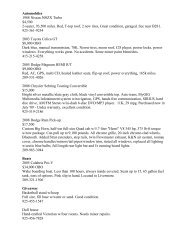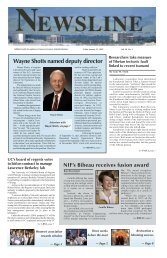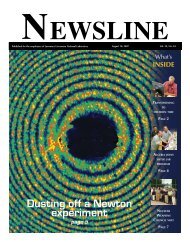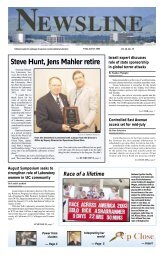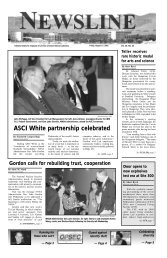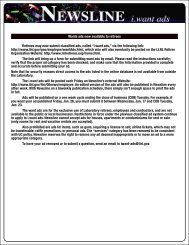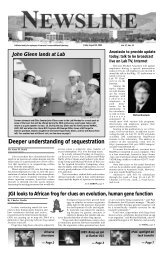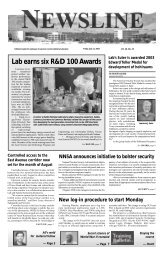What's INSIDE - NEWSLINE - Lawrence Livermore National ...
What's INSIDE - NEWSLINE - Lawrence Livermore National ...
What's INSIDE - NEWSLINE - Lawrence Livermore National ...
Create successful ePaper yourself
Turn your PDF publications into a flip-book with our unique Google optimized e-Paper software.
8 <strong>NEWSLINE</strong><br />
August 3, 2007<br />
SCIENCE NEWS<br />
Survival strategies of the California red-legged frog<br />
By Karen Jensen<br />
The federally protected California redlegged<br />
frog (Rana aurora draytonii) can be found<br />
in streams, ponds, marshes and artificial water sources such<br />
as stock ponds. Here at the Laboratory, you might observe these crimson hued<br />
creatures at Lake Haussmann and Arroyo Las Positas, or in the wetlands of Elk<br />
Ravine and Gooseberry Canyon at Site 300.<br />
Often these aquatic habitats available to frogs are isolated from each<br />
other by wide expanses of terrestrial habitat. These seemingly isolated<br />
frog populations are linked together to form a larger group referred to as a<br />
metapopulation.<br />
The populations of frogs that make up the metapopulation operate<br />
independently of each other. However, during certain times of the year, some<br />
frogs will travel beyond their usual pond either to the surrounding terrestrial<br />
habitat in search of food or shelter, or to migrate to another aquatic habitat.<br />
Throughout the summer months, California red-legged frogs often move<br />
into terrestrial areas to forage and seek shelter. During this period, frogs can<br />
be found under boulders or rocks and organic debris, such as downed trees<br />
or logs; industrial debris; and agricultural items like drains, troughs or sheds.<br />
Small burrows, like those made by ground squirrels, provide an important<br />
u.s. fish and wildlife service.<br />
Above: Aerial view of California red-legged frog breeding<br />
(aquatic) habitat surrounded by terrestrial habitat. Inset:<br />
An adult California red-legged frog wearing a radiotransmitter.<br />
This is a device that can help biologists study<br />
movement and habitat use within the metapopulation.<br />
Background image: This wetland at Elk Ravine is used by<br />
California red-legged frogs. credit: corey cate<br />
Photo by<br />
Michael van hattaM<br />
safe haven from the intense summer heat. Moist leaf<br />
litter and narrow stream channels also allow the frogs to<br />
hunker down, waiting for the fall rains. Frogs will even use<br />
the deep cracks of drying ponds, anything that provides shade, cooler<br />
temperatures, and a bit of moisture.<br />
During periods of wet weather, some frogs use the rain to travel<br />
overland and settle in new aquatic habitats. This usually begins with<br />
the first rains of the fall and most of these overland movements happen<br />
at night. Frogs can travel under these conditions for distances of more<br />
than 1.9 miles (3 kilometers) with no apparent regard to topography,<br />
vegetation type or riparian corridors.<br />
Movements of individual frogs throughout the metapopulation<br />
allows for the exchange of individuals and recolonization in the event<br />
of a local extinction. Access to appropriate terrestrial habitat allows the<br />
frogs to survive throughout periods of drought and heat.<br />
Biologists and resource managers are attempting to understand the<br />
survival strategies of the California red-legged frog. One thing is certain:<br />
the frogs, not only at LLNL’s sites but throughout the region, have the<br />
greatest chance of survival when there are multiple areas of suitable<br />
aquatic habitat connected by suitable terrestrial habitat.<br />
NON-PROFIT ORG.<br />
U.S. POSTAGE<br />
PAID<br />
LIVERMORE, CA<br />
PERMIT NO. 154<br />
Newsline<br />
UC-LLNL<br />
PO Box 808, L-797<br />
<strong>Livermore</strong>, CA 94551-0808<br />
An adult California red-legged frog.<br />
Photo by Michael van hatteM, ePd




